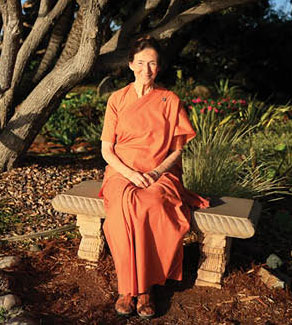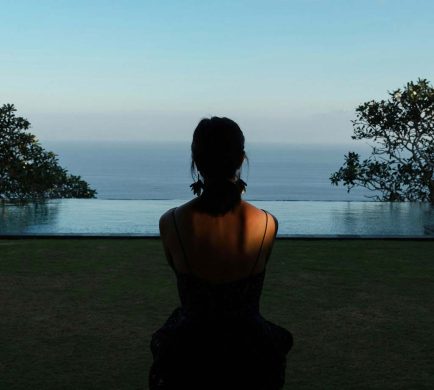An interview with Sister Ranjana
Reflections on the Teachings of Paramahansa Yogananda With Self-Realization
Fellowship Nun Sister Ranjana
Paramahansa Yogananda taught that true strength comes from inner peace. How can one cultivate peace and stability, even during external turmoil or personal hardship?
Paramahansa Yogananda taught that true strength comes from inner peace. How can one cultivate peace and stability, even during external turmoil or personal hardship?
Sister Ranjana: The world is going through rapid changes, and various situations arise that can cause us to lose our inner peace — fears, insecurities, uncertainties about finances, the future, and so on. Security, strength, stability — everything we seek is generally sought externally. But nothing in this world is permanent. Lasting peace and stability are found when we realize we are souls, children of God, essentially untouched by outer circumstances. We can play our role in life without worries by doing our best and not being too attached to the results.
Self-Realization Fellowship President Brother Chidananda talks about how a regular meditation practice is crucial for coping with the modern world: “Taking a little time, first thing in the morning and before retiring at night, to enter into the inner stillness will help us face the unendingly diverse challenges to our peace of mind and emotional stability, and will reinforce the connection to our divine nature. That is our only realistic hope of preserving the divine attitude and manifesting divine qualities during our daily lives.”
Many seekers struggle with self-doubt on their spiritual journeys. What advice from Yogananda’s teachings can help individuals overcome inner obstacles and trust in their own divine potential?
SR: When we start a real search for God, we may have an idea or an expectation of how we feel we should be. At the same time, we begin to become aware of inner obstacles that we may not have noticed before. Now we want to rid ourselves of them because we see they are in our way, while at the same time finding it’s not always easy to do. This can feel discouraging and cause us to doubt ourselves. But the truth is that we have more inner strength than we will ever need.
Yogananda said, “You have come into this world without realizing what marvelous faculties you possess….Your soul is a beacon of infinite power. You can expand that power from within and give light and health and understanding to others.”
One of Yogananda’s affirmations — statements of truth — that we can commit to reminding ourselves again and again is:
“There is hidden strength within me to overcome all obstacles…. I will bring forth that indomitable power and energy.”
Yogananda often spoke about the power of divine will. How can individuals cultivate inner strength through meditation in their daily lives?
SR: Yogananda said that “Divine Will has no boundaries; it works through laws known and unknown, natural and seemingly miraculous. It can change the course of destiny….Man, as an image of God, possesses within him that all-accomplishing power of will. To discover through right meditation how to be in harmony with the Divine Will is man’s highest obligation.”
Yogananda brought India’s ancient science of yoga meditation to the West in his Kriya Yoga teachings. The daily concentrated practice of the techniques he taught gradually shifts our attention and consciousness from restless body identification to communion with the indwelling Spirit, awakening our own inner strength. Yogananda said that the specific Kriya Yoga technique was the one he found to be the highest for realizing God, the source of all strength.
Along with meditation, as part of the Kriya Yoga way of life, Yogananda stressed the importance of the right activity. Living by universal spiritual principles, our activities support our meditations, and our meditations support our activities, and we discover the willpower we have. Yogananda said that power can be eclipsed for a time by bad habits or other influences, but most importantly: “You have all the willpower in the world to break any habit. The power of divine will is always with you, and can never be destroyed.”
Yogananda emphasized the balance between spiritual practice and worldly responsibilities. How can people integrate meditation and spiritual principles into a busy modern lifestyle?
SR: Balancing our material and spiritual life means learning “to be in the world but not of it,” as Yogananda put it — performing our responsibilities while keeping our mind on God, sharing our life with that divine Presence.
He explained, “Harmony between one’s material and spiritual duties is the outward expression of a balanced life. There is also an inner aspect. Without inner balance, calmness, and poise, one’s troubles are seemingly endless. Balance means the ability to preserve your inner peace and happiness in all circumstances during the spiritual battle of daily life.”
Yogananda’s teachings show the universal art of right living that balances body, mind, and soul. First, meditate to establish a connection with God. Then carry that awareness of the Divine’s presence into your activities — so we are only influenced by those things that contribute to our true well-being and that of others and that reflect our soul qualities in our outer life.
As we celebrate Yogananda’s legacy, what is the most important lesson from his teachings that can help people awaken their highest potential and lead a more fulfilling life?
SR: The unique, priceless gift Yogananda gave to the world is what I mentioned earlier: India’s ancient science of yoga, specifically Kriya Yoga, which is taught in his Self-Realization Fellowship Lessons. Through the scientific practice of yoga, right activity, and desire for God, we can discover our highest potential. This is the purpose of life. The more we draw nearer to that divine state of consciousness, the more joyous and fulfilled we are; it is not dependent on outer circumstances but on inner realization of our true Self. There is nothing greater than to live in that state of consciousness. Our souls want to be reunited with God in that oneness of Eternal Bliss — and that is what Paramahansa Yogananda shows us how to achieve.
Sister Ranjana, whose name means “to worship, please, gladden, and serve the Divine,” has been a member of the Self-Realization Fellowship (SRF) monastic community for over 40 years. She played a key role in the development of the SRF Youth Services Department and served young people and their parents. Sister Ranjana provides spiritual counseling to SRF members and friends and conducts inspirational services and retreats. She currently resides at the SRF Ashram Center in Encinitas, California.
Paramahansa Yogananda (1893-1952) first arrived in America in 1920 from his native India, an invited delegate to an International Congress of Religious Liberals convening in Boston, where he delivered a speech on the science of religion, marking a pivotal point for yoga in the West. Yogananda founded the Self-Realization Fellowship that same year to disseminate his Kriya Yoga teachings, which have inspired many through the years to cultivate their divine qualities and live with greater peace, joy, and purpose. Yogananda’s spiritual classic Autobiography of a Yogi continues to be recognized as one of the world’s most influential books.
For more information about Paramahansa Yogananda and his Self-Realization Fellowship Lessons, please visit Yogananda.org.







